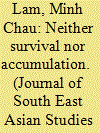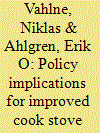| Srl | Item |
| 1 |
ID:
178510


|
|
|
|
|
| Summary/Abstract |
This article investigates the gender role attitudes and domestic division of labour of young couples in northern Vietnam. Based on separate interviews with 30 couples living in rural and urban areas, it explores young people's thoughts about the roles of a wife and a husband and how these translate into their allocation of housework. Analysis of the interviews indicates that the perceptions and expectations of young people remain influenced by traditional gender ideology, in that wives are still considered mainly responsible for housework. However, in practice, gender roles are highly flexible and demonstrate significant mutual support. In addition, the similarities or differences between spouses in terms of gender role attitudes contribute to levels of relative satisfaction regarding the current division of labour in households.
|
|
|
|
|
|
|
|
|
|
|
|
|
|
|
|
| 2 |
ID:
179129


|
|
|
|
|
| Summary/Abstract |
Building on ethnographic fieldwork in a northern Vietnamese village, this article explores how rural households have negotiated the opportunities and uncertainties of marketisation (Đổi Mới). I focus on the surprising ways local households have handled the state's push to diversify livelihoods and adopt commercial home-based sidelines: by means of being đa gi năng, a local term that means ‘keeping many livelihood options and never putting all eggs in one basket’. In pursuit of đa gi năng, local households have actively adopted home-based production even when they were doing well with paddy farming and faced no subsistence crisis. However, they have evaded what state officials want most: specialising in a single home-production enterprise in rational maximising ways to accumulate transformational wealth. The idea of đa gi năng calls into question two contrasting universal approaches to rural households’ motivations for livelihood diversification: either a desperate search for survival by passive victims of market forces, or a quest for wealth accumulation by rational maximisers without careful judgement of potential risks to one's family.
|
|
|
|
|
|
|
|
|
|
|
|
|
|
|
|
| 3 |
ID:
128011


|
|
|
|
|
| Publication |
2014.
|
| Summary/Abstract |
Despite the long history of cook stove programs, very few have been successful, often only in areas where biomass is purchased or there is a biomass shortage. Several studies have described how rural households generally rely on several different fuels; which fuels are used may depend on various household characteristics such as location and income. This article explores possible consequences of variations in fuel usage for improved cook stove programs and how this may vary between different areas. Reductions of CO2 equivalent emissions and monetary savings are calculated for hypothetical cook stove deployment using data from a rural energy survey in the V?nh Phúc province of northern Vietnam. The results indicate that the areas may respond differently to the various stove options, both in terms of economy and emission reductions. Furthermore, there are large differences in emission reduction calculations when only Kyoto-gases are included and when non-Kyoto greenhouse agents are added. Assumptions regarding household behavior and stove efficiencies have large impacts on the results, indicating a need for further research on how improved cook stoves may influence households' fuel choices.
|
|
|
|
|
|
|
|
|
|
|
|
|
|
|
|